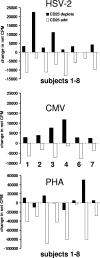Human CD4+ CD25 high cells suppress proliferative memory lymphocyte responses to herpes simplex virus type 2
- PMID: 16873284
- PMCID: PMC1563823
- DOI: 10.1128/JVI.00656-06
Human CD4+ CD25 high cells suppress proliferative memory lymphocyte responses to herpes simplex virus type 2
Abstract
Lymphocytes with the regulatory CD4+ CD25+ phenotype frequently suppress memory T-cell responses. Murine herpes simplex virus type 1 (HSV-1) models have shown that CD4+ CD25+ cells can limit immunity-mediated corneal damage but slow viral clearance. We investigated the effect of CD4+ CD25+ cells from healthy HSV-2-infected humans on recall proliferative (CD4) responses to HSV-2. Depletion and reconstitution experiments were consistent with a suppressive effect of autologous blood-derived CD4+ CD25+ cells for whole HSV-2 antigen. Regulatory T cells may modulate human CD4 memory responses to HSV-2 and influence their antiviral and inflammatory functions.
Figures


Similar articles
-
CD8+ T-cells suppress antigen-specific and allogeneic CD4+ T-cell responses to herpes simplex virus type 2-infected human dendritic cells.Viral Immunol. 2005;18(4):616-26. doi: 10.1089/vim.2005.18.616. Viral Immunol. 2005. PMID: 16359228
-
Innate immune responses to herpes simplex virus type 2 influence skin homing molecule expression by memory CD4+ lymphocytes.J Virol. 2006 Mar;80(6):2863-72. doi: 10.1128/JVI.80.6.2863-2872.2006. J Virol. 2006. PMID: 16501095 Free PMC article.
-
CD4+ CD25+ T cells regulate vaccine-generated primary and memory CD8+ T-cell responses against herpes simplex virus type 1.J Virol. 2004 Dec;78(23):13082-9. doi: 10.1128/JVI.78.23.13082-13089.2004. J Virol. 2004. PMID: 15542660 Free PMC article.
-
Type 1 T regulatory cells and their relationship with CD4+CD25+ T regulatory cells.Novartis Found Symp. 2003;252:115-27; discussion 127-31, 203-10. Novartis Found Symp. 2003. PMID: 14609215 Review.
-
The role of suppressor T cells in regulation of immune responses.J Allergy Clin Immunol. 2002 Nov;110(5):693-702. doi: 10.1067/mai.2002.129339. J Allergy Clin Immunol. 2002. PMID: 12417876 Review.
Cited by
-
CD4+ T cells are the major predictor of HCMV control in allogeneic stem cell transplant recipients on letermovir prophylaxis.Front Immunol. 2023 May 10;14:1148841. doi: 10.3389/fimmu.2023.1148841. eCollection 2023. Front Immunol. 2023. PMID: 37234158 Free PMC article.
-
CD137 costimulation of CD8+ T cells confers resistance to suppression by virus-induced regulatory T cells.J Immunol. 2008 Apr 15;180(8):5267-74. doi: 10.4049/jimmunol.180.8.5267. J Immunol. 2008. PMID: 18390707 Free PMC article.
-
Mechanisms of Immune Control of Mucosal HSV Infection: A Guide to Rational Vaccine Design.Front Immunol. 2019 Mar 6;10:373. doi: 10.3389/fimmu.2019.00373. eCollection 2019. Front Immunol. 2019. PMID: 30894859 Free PMC article. Review.
-
Herpes simplex virus-2 dynamics as a probe to measure the extremely rapid and spatially localized tissue-resident T-cell response.Immunol Rev. 2018 Sep;285(1):113-133. doi: 10.1111/imr.12672. Immunol Rev. 2018. PMID: 30129205 Free PMC article. Review.
-
Inflammation and viral infection as disease modifiers in schizophrenia.Front Psychiatry. 2023 Oct 2;14:1231750. doi: 10.3389/fpsyt.2023.1231750. eCollection 2023. Front Psychiatry. 2023. PMID: 37850104 Free PMC article. Review.
References
-
- Beissert, S., A. Schwarz, and T. Schwarz. 2006. Regulatory T cells. J. Investig. Dermatol. 126:15-24. - PubMed
-
- Boettler, T., H. C. Spangenberg, C. Neumann-Haefelin, E. Panther, S. Urbani, C. Ferrari, H. E. Blum, F. von Weizsacker, and R. Thimme. 2005. T cells with a CD4+ CD25+ regulatory phenotype suppress in vitro proliferation of virus-specific CD8+ T cells during chronic hepatitis C virus infection. J. Virol. 79:7860-7867. - PMC - PubMed
-
- Corey, L., and A. Wald. 1999. Genital herpes, p. 285-312. In K. K. Holmes, P. F. Sparling, P. A. Mardh, S. M. Lemon, W. E. Stamm, P. Piot, and J. M. Wasserheit (ed.), Sexually transmitted diseases, 3rd ed. McGraw-Hill, Inc., New York, N.Y.
Publication types
MeSH terms
Substances
Grants and funding
LinkOut - more resources
Full Text Sources
Research Materials

